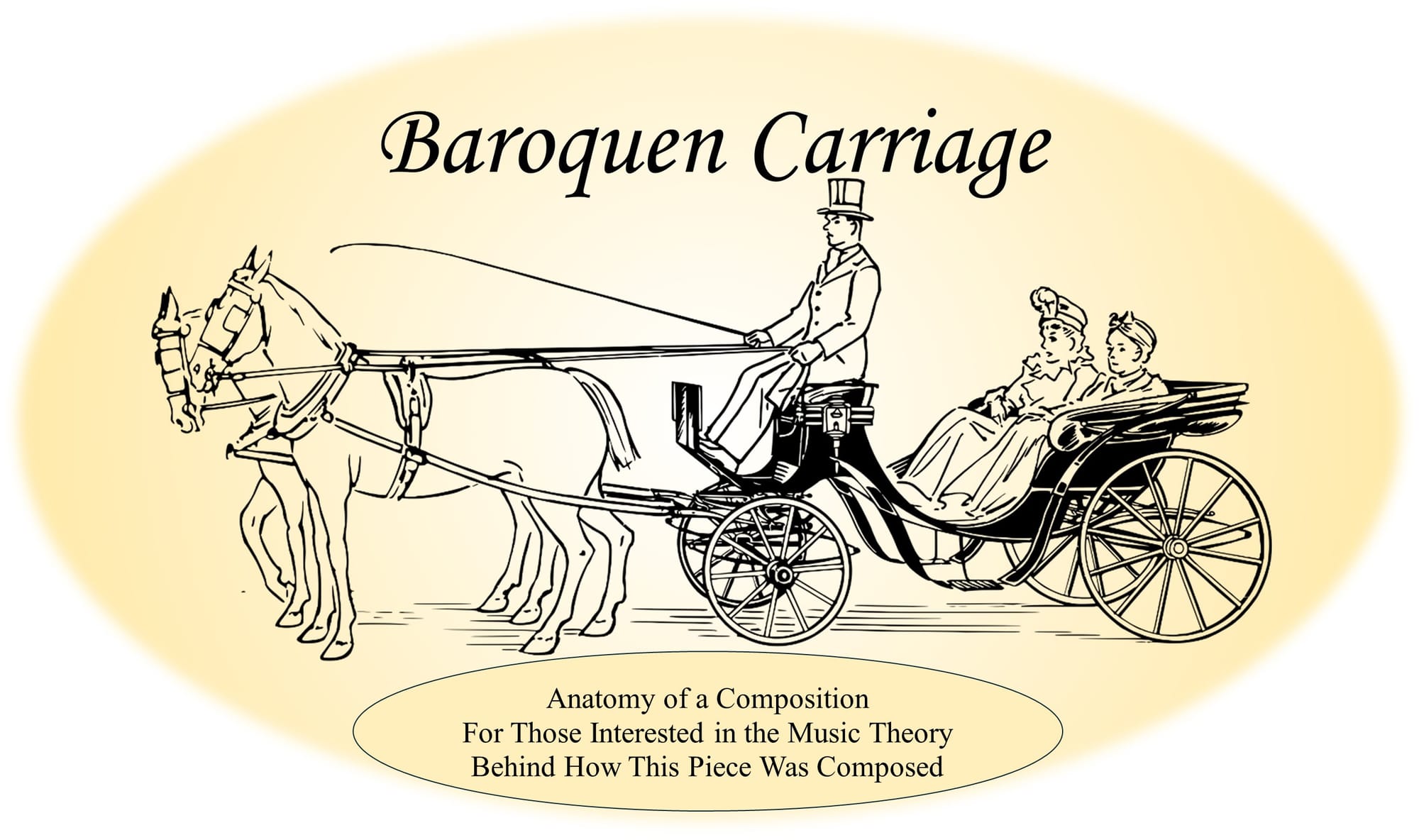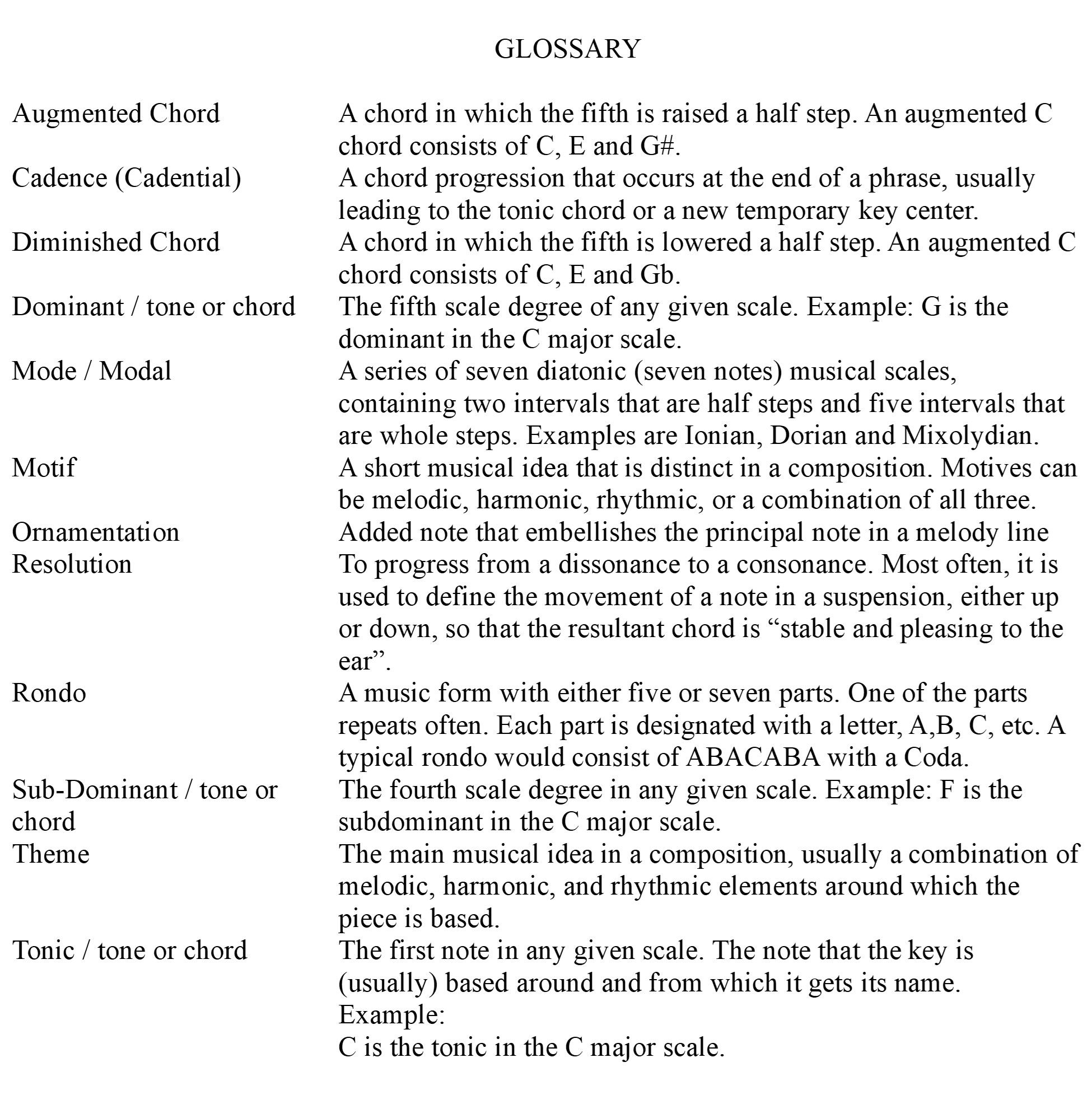Anatomy of a Composition – "Baroquen Carriage" for Concert Band

The “Anatomy of a Composition” series of articles is for anyone interested in the composition process, or for Music Theory teachers and students. These articles will supply enough information to understand the basic elements of the song, while allowing for independent study of the particulars of each element. If you need more information, please Contact Us. We’re always glad to help people learn about composing and arranging.
This article contains some technical music theory terms. If you need help remembering a term or two, there is a glossary of terms at the end. There may be more definitions than you need.
In this article, we’ll be looking at “Baroquen Carriage”, a piece for Concert Band. The music was inspired by the classic song “Classical Gas” by Mason Williams which was popular in the 1970s. The name is a strange composite of words in an adjective-noun sequence. Larry Norman wrote a song called “Baroquen Spirits” and I liked the reference to the Baroque era. The “Carriage” part of the name came from the classy connotation that it has. It’s not a wagon or a buggy, but something more sophisticated. The aim was to make this piece a bit fancy and sophisticated.
Click HERE to go to the Salt Cellar web page with info about “Baroquen Carriage”. There, you’ll find links to the YouTube video, print sample and purchase option.
Key Choice: Baroque Carriage has two flats throughout and wanders back and forth between the key of G minor and Bb major. The transition is easy, of course, because they are relative to each other. I chose this key signature because it is fairly easy to play. That way, the musicians can concentrate on the challenges in it instead of fingerings.
Time Signature Choice: Since this was inspired by “Classical Gas”, it starts in 3/4 and then switches to 4/4. The beginning is also a bit slower than the rest of the piece.
Chord Structure: I won’t reveal all of the chord progressions, but here are a few insights.
- The first eight measures establish the basic chord progression for the main theme in the piece. It’s a very old progression. J.S. Bach used its basic structure in his “Toccata and Fugue in D Minor”. It goes like this – i, Flat-VII, Flat-VI, Flat-VII, i, Flat-VII, Flat-VI, V. The last four measures are a direct lift from the Bach toccata. The half-step cadence is mimicked in the later use of suspensions and their resolutions.
- Measures 8 and 9 use an Augmented Five resolved to a Five as a cadence.
- Measure 45 also uses an Augmented Five but then, in measures 46 - 48 uses the same feel to go to a series of descending suspensions with resolutions to resolve solidly on a Bb chord, which sets the song up for the next section.
- The next section, in measures 51 – 66, uses what could be described as a mixolydian-mode based progression.
Form and Description: “Baroquen Carriage” is in a short rondo form, with some connecting material. The sections are:
- Introduction – In 3/4 time, using a modal progression similar to progressions in the Baroque era. The melody expands and contracts on itself before going through an augmented dominant and dominant chord to establish the key as G minor for the next section. There is a short, two measure, repeat of the cadence at the new tempo to also establish the new tempo.
- A section – In 4/4 time, using the same chord progression as the introduction. The melody is an elongation of the one in the introduction. It’s repeated twice. The first time, it’s played by the brass with the counter-motion emphasized by the lower woodwinds. The second time, the brass still play the melody while the upper woodwinds add some staccato rhythm to add to the intensity of the section. Then, there is a transition to the next section using an augmented dominant and dominant chord progression.
- B section – Uses a chord progression that might be called more folk than anything. The melody is also a folk-type melody. The chord progression uses a vi, V cadence instead of a more common IV, V. The vi, V cadence is quite common in old English folk music and mountain music of the United States. It may have been used more because of the way that the more common instruments, the lap dulcimers and banjoes, were tuned. The IV note would be dissonant on those instruments, especially in the hands of a less skilled player.
- Over-arching the melody is a counter melody being played by the flutes and oboes, sounding like a hornpipe piece in and of itself.
- C section – The chord progression in the C section sounds like a Mixolydian Mode, I, flat VII, IV, V. It’s an eight bar phrase, using the same chords and a variation on the melody, but the second time through, it uses a relatively modern dominant chord in that it’s suspended and then resolved. When modes were being used, suspended chords were the exception rather than the rule, and they weren’t often used to color a dominant chord. What they would do is use a prepared five chord in which the bass note of the chord would be the five of the scale, then the chord would be repeated with the bass playing the tonic note. It set up a bit of tension and release.
The C section is also repeated, gaining vigor by adding brass instruments and, at the end, gains speed to present the last section.
- A section – This final rendition of the main theme is a combination of some of the main thematic elements used in other parts of the piece. It’s loud and rambunctious and showy.
- Coda – The coda is a very simple trail from the key of G minor to a Picardy third, a G major chord.
Secrets In It: There are some hidden musical devices in this song.
- I used the Bach “loud rest” quite often. Bach wrote the “loud rest” by simply putting a rest, usually an eighth rest, at the beginning of the measure, creating the aural illusion of a strong downbeat. One of the more well-known examples of this is his Invention 1 in C Major from the Well-Tempered Clavichord.
- The augmented dominant chord, and its resolution, are borrowed from Bach as well. He used it in quite a few of his works, choral and organ, and often not for a cadence. I used it purely for its cadential function because I think that usage works best for that chord. There are, of course, many other uses, but they must be carefully chosen.
“Baroquen Carriage” isn’t very long, but it contains a wealth of musical ideas to make it a compelling piece to hear.
Salt Cellar Creations has a growing library of original works and arrangements that not only sound great when you ensemble plays them, but are equally suited to music theory analysis. Find out more about the available music Salt Cellar Creations HERE.
SCC can also compose an original piece for you or do a custom arrangement for you. There are two ways that this can be done; one is much more affordable than the other. And SCC is always looking for ideas of pieces to arrange or suggestions for original pieces.
We have sold music not only in the US but in Canada, the United Kingdom, France, Australia, New Zealand and Austria. Please visit the WEBSITE or CONTACT US to let us know what we can do for you!
